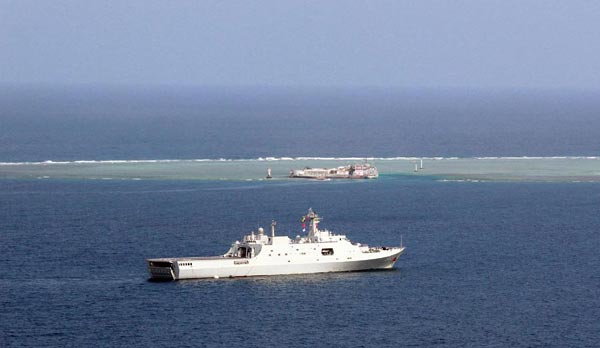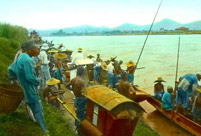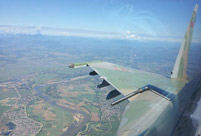

 |
Marcus Hitchcock, the newly minted commander of the carrier strike group led by the USS John C. Stennis, recently told media that his ships have been engaged on “almost a twenty four-seven basis” with a “completely professional” People’s Liberation Army Navy.
“We have had nothing but professional interactions,” he said on Monday on the flag deck of the John C. Stennis. His words were interpreted by Western media as praise for the PLA Navy. However, by "professional," Hitchcock means that the PLA Navy has implemented the Code for Unplanned Encounters at Sea (CUES).
CUES was first put forward by Australia and New Zealand, and then officially published in 2000 during the Western Pacific Naval Symposium. Ever since, many member countries have contributed amendments and expressed further ideas about it.
After China decided to host the annual meeting in 2012, it amended the code based on the results of consultation with other member states. During the workshop held in Nanjing in 2014, the member states reached a consensus over those changes.
Meanwhile, China has great respect for CUES. The code sets rules for what safety measures should be taken to reduce interference and minimize risk when it comes to unplanned encounters between different Navies. The code explains the legal standing as well as the obligations and rights of naval ships and aircraft. It also introduces safety and communication procedures for when unplanned encounters do happen in order to prevent those events from escalating.
CUES could help China and the U.S. to promote and implement non-confrontation in the new model of relations between the two countries. Last December, China and the U.S. carried out their first joint military drill in the Atlantic Ocean based on CUES.
It is true that the PLA Navy deserves praise. However, the American commander shouldn't be tricky in his speech, nor should he defend U.S. hegemony with CUES. Hitchcock said in the interview that in an effort to demonstrate the "freedom of navigation," the U.S. had started to dispatch battleships to cruise near the islands over which China claims sovereignty.
Even though the commander reiterated that the U.S. will not take sides on the South China Sea issue, he still intended for that action to challenge China’s claims. According to an annual report released by the U.S Department of Defense, the U.S. has taken action in the name of "navigation freedom" against 13 countries and regions including China, India and Indonesia. This time, the U.S. claims that its actions against China aim to challenge China’s right of jurisdiction over the airspace above its exclusive economic zones, as well as its practice of restricting flights in air defense identification zones.
But what the U.S. did obviously goes against the original meaning of "freedom of navigation" and the spirit of CUES. CUES was assembled on the basis of respect for international conventions and with the aim to promote mutual trust between different Navy forces in the region. The U.S. demonstration of military power in the South China Sea violated CUES. The so-called "freedom of navigation" proposed by the U.S. is actually anything but that.
China is making efforts with ASEAN states to protect the peace and stability of the South China Sea through cooperation. The U.S. should play a constructive role in this effort and meet China halfway.
(The author is an expert on international studies.)
 Beijing Style: ready for bare legs
Beijing Style: ready for bare legs Top 10 Asian beauties in 2016
Top 10 Asian beauties in 2016 Amazing scenery of Xisha Islands
Amazing scenery of Xisha Islands Enthusiasts perform Kung Fu at Wudang Mountain
Enthusiasts perform Kung Fu at Wudang Mountain Stunning photos of China's fighter jets in drill
Stunning photos of China's fighter jets in drill Old photos record the change of Sichuan over a century
Old photos record the change of Sichuan over a century Asia's longest and highest suspension bridge to open to traffic
Asia's longest and highest suspension bridge to open to traffic China's first interactive robot looks like a beauty
China's first interactive robot looks like a beauty Vietnamese Su-30 fighters fly over Nanwei Island in South China Sea
Vietnamese Su-30 fighters fly over Nanwei Island in South China Sea Top 20 hottest women in the world in 2014
Top 20 hottest women in the world in 2014 Top 10 hardest languages to learn
Top 10 hardest languages to learn 10 Chinese female stars with most beautiful faces
10 Chinese female stars with most beautiful faces China’s Top 10 Unique Bridges, Highways and Roads
China’s Top 10 Unique Bridges, Highways and Roads Showy knife skills make for edgy TV
Showy knife skills make for edgy TV  Cross-Straits relations face a reversal
Cross-Straits relations face a reversal  Officials’ relatives banned from business in four new regions
Officials’ relatives banned from business in four new regions  Death of Mei Baojiu triggers concern for the future of Peking Opera
Death of Mei Baojiu triggers concern for the future of Peking Opera Day|Week